There is perhaps no more revered term in the realm of physical fitness than the word “cutting.” Navigating the challenge of shedding pounds and reducing calorie intake without compromising one’s strength and muscle mass demands a careful approach. Fortunately, I have designed a cutting-edge strategy that you can adopt. In the following section, I will outline a comprehensive seven-day plan aimed at helping you trim body fat while simultaneously enhancing muscle growth.
When getting shredded and revealing lean, defined muscles, a cutting routine is a go-to strategy for athletes, bodybuilders, and anyone looking to dial in their physique. Cutting isn’t just about lifting weights or cranking out cardio; it’s a calculated approach that combines the right mix of strength training, high-intensity intervals, and proper nutrition to torch fat while maintaining muscle mass. The goal is simple: Strip away excess body fat without sacrificing the hard-earned muscle that gives you that chiseled look.
This seven-day cutting routine maximizes fat loss by pushing your body through a strategic blend of full-body strength circuits, high-intensity interval training (HIIT), and steady-state cardio. Combining these elements will burn calories during and after your workouts, tap into stubborn fat stores, and preserve your muscle mass. To make this routine even more effective, I’ll guide you through essential tips for proper warm-ups, why they’re crucial to your fat-loss success, and how to optimize every workout for maximum results.
Key Components of an Effective Fat-Burning Cutting Routine

An effective fat-burning cutting routine is all about striking the right balance between strength training and cardio while focusing on proper nutrition to fuel your workouts and recovery. To burn fat and get ripped, your routine should include compound strength exercises to maintain muscle mass, high-intensity interval training (HIIT) to maximize calorie burn, and steady-state cardio for fat oxidation.
Progressive overload—gradually increasing the weight or intensity over time—is essential to continuously challenge your muscles, while a caloric deficit in your diet helps shed excess fat.
One key component to remember is consistency. Results come from adhering to your workout plan and pairing it with a nutrient-dense diet that supports muscle maintenance while cutting fat.
Strength training, particularly with full-body circuits, ensures you maintain lean muscle mass as you lose fat. HIIT and steady-state cardio are potent tools for improving your metabolism and increasing your overall calorie expenditure. Combining these elements will help you burn fat efficiently while keeping your muscles full and defined.
Why Warming Up is Crucial and How to Do It Right for Maximum Fat Loss

Warming up correctly is a critical step in any fat-burning cutting routine because it prepares your body for the intensity of the workout ahead. By elevating your heart rate, increasing blood flow to your muscles, and mobilizing your joints, a good warm-up helps prevent injuries and ensures you can push yourself during your workout.
Warm muscles are more elastic, reducing your injury risk and enhancing your range of motion, allowing you to lift heavier weights and perform movements more efficiently—both essential for optimizing fat loss.
For maximum fat loss, your warm-up should be dynamic and tailored to the workout you’re about to do. Start with five to 10 minutes of light cardio to get your heart rate up and blood flowing, followed by dynamic stretches and movements that mimic the exercises in your workout.
If you’re doing strength training, incorporate bodyweight squats, lunges, or hip circles to activate your muscles. For cardio-focused days, like HIIT or steady-state intervals, consider adding quick movements like high knees or jumping jacks to prepare your body for the higher intensity.
A well-structured warm-up sets the tone for a more effective workout, allowing you to perform at your best and burn the most calories.
7-Day ‘Cutting’ Routine
Day 1: Full-Body Strength Circuit
What You Need: For this workout, you’ll need a set of dumbbells, kettlebells, and a barbell. This strength circuit is designed to hit every major muscle group and will take 45 minutes to complete. Make sure you have enough space to move between exercises with minimal rest.
The Routine:
- Barbell Deadlifts – 4 sets of 8 reps
- Kettlebell Goblet Squats – 3 sets of 12 reps
- Dumbbell Bench Press – 4 sets of 10 reps
- Dumbbell Renegade Rows – 3 sets of 10 reps (each side)
- Kettlebell Swings – 3 sets of 20 reps
Directions: Move through the exercises with minimal rest between sets. Rest for 60–90 seconds between circuits. Complete all exercises in the circuit before resting. Aim for three rounds.
1. Barbell Deadlifts
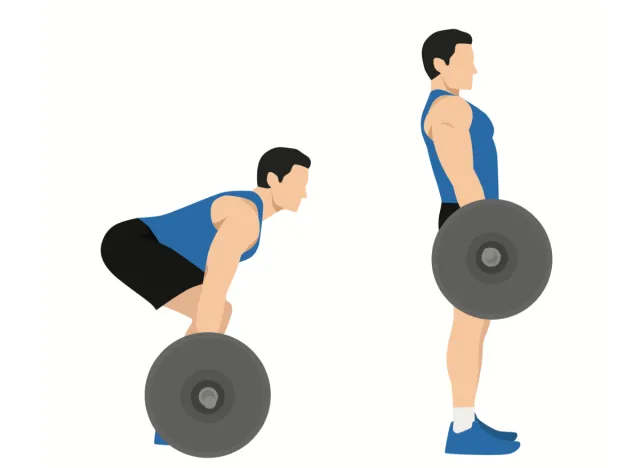
- Stand with your feet hip-width apart, with a barbell on the floor in front of you.
- Bend at your hips and grip the barbell just outside your knees.
- Keeping your chest up and back straight, push through your heels to lift the bar, driving your hips forward as you stand.
- Lower the bar in a controlled motion.
2. Kettlebell Goblet Squats
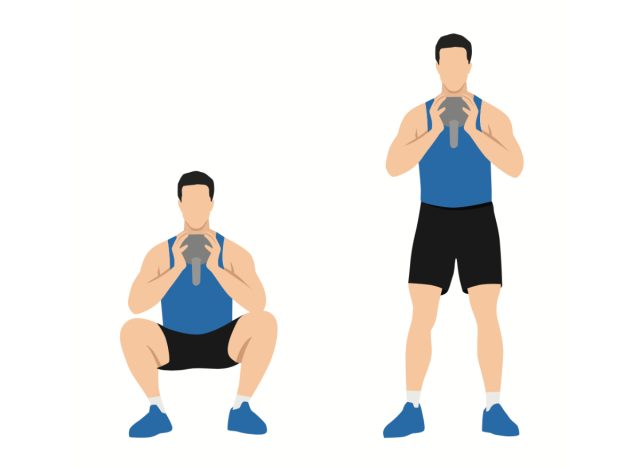
- Hold a kettlebell close to your chest with both hands.
- Stand with feet shoulder-width apart, toes slightly out.
- Lower your body into a squat by bending your knees and hips.
- Keep your chest up and core tight.
- Drive through your heels to return to standing.
3. Dumbbell Bench Press
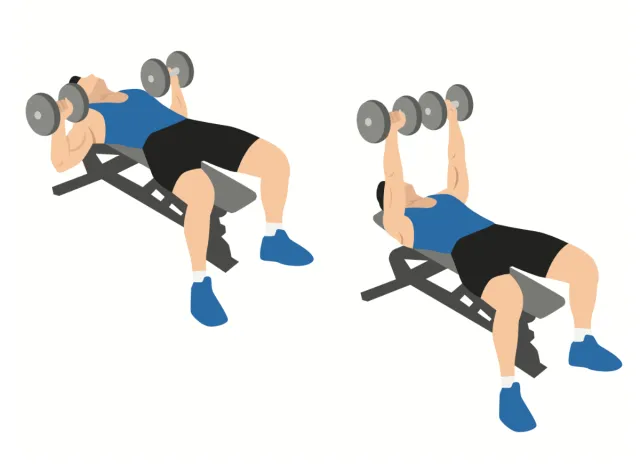
- Lie flat on a bench with a dumbbell in each hand.
- Start with your arms extended above your chest, palms facing forward.
- Lower the dumbbells slowly until they’re in line with your chest.
- Press back up to the starting position.
4. Dumbbell Renegade Rows
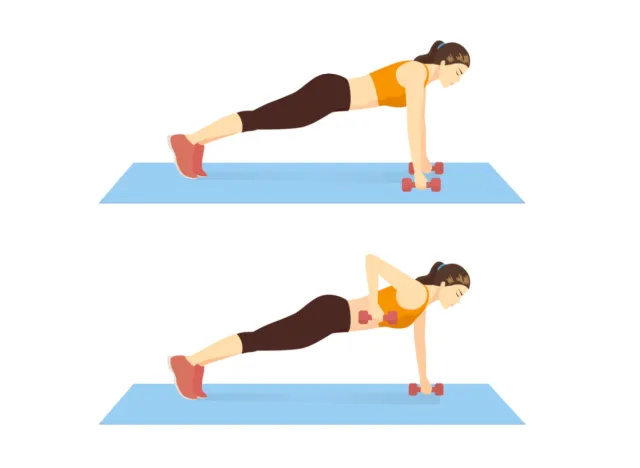
- Get into a high plank position with dumbbells in each hand.
- Brace your core row one dumbbell toward your ribcage while keeping your hips level.
- Lower it back down and repeat on the other side.
5. Kettlebell Swings
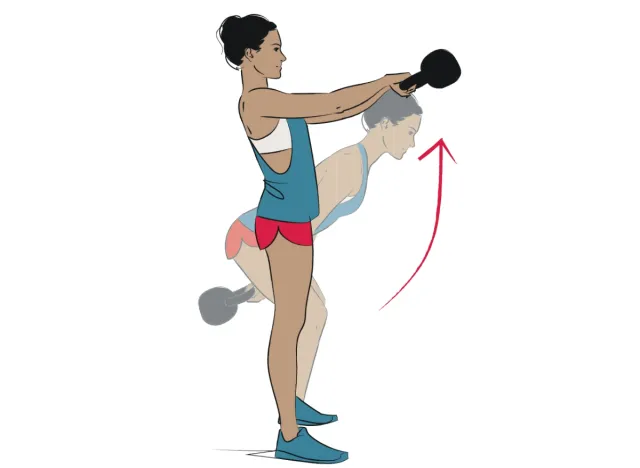
- Stand with feet shoulder-width apart, with a kettlebell on the floor in front.
- Grip the kettlebell with both hands and pull it between your legs as you hinge at the hips.
- Drive your hips forward to swing the kettlebell up to shoulder height.
- Pull the kettlebell back down between your legs and repeat.
Day 2: HIIT Intervals on Cardio Machine of Choice + Steady-State Wrap-Up
What You Need: Grab your cardio machine of choice—whether it’s a treadmill, rower, or assault bike—and prepare for an intense session. You’ll be doing 20 minutes of HIIT intervals followed by 30 minutes of steady-state cardio, making this a 50-minute workout in total. Be sure to choose a machine you’re comfortable pushing hard on.
The Routine:
- High-Intensity Intervals: 20 seconds sprint, 40 seconds rest (20 minutes total)
- Steady-State Cardio: Moderate pace (30 minutes)
Directions: Alternate between high-intensity intervals and rest or light effort for the HIIT portion. After completing 20 minutes of HIIT, switch to steady-state cardio for 30 minutes at a moderate pace.
1. High-Intensity Intervals

- Set your machine for sprints (treadmill, rower, etc.).
- Sprint at maximum effort for 20 seconds.
- Recover with light effort for 40 seconds.
- Repeat for 20 minutes.
2. Steady-State Cardio

- Lower the intensity to a moderate pace after completing the HIIT session.
- Maintain a steady, moderate pace for 30 minutes without stopping.
Day 3: Full-Body Strength Circuit
What You Need: This strength circuit, which will take about 45 minutes to complete, requires a barbell, dumbbells, and kettlebells. It targets your entire body and focuses on building strength while keeping your heart rate elevated.
The Routine:
- Barbell Squats – 4 sets of 8 reps
- Dumbbell Overhead Press – 3 sets of 10 reps
- Kettlebell Lunges – 3 sets of 12 reps (each leg)
- Barbell Bent-Over Rows – 4 sets of 10 reps
Directions: Complete the exercises in the order listed, minimizing rest between sets. Take a 60–90-second rest after each round, aiming to complete 3 rounds.
1. Barbell Squats
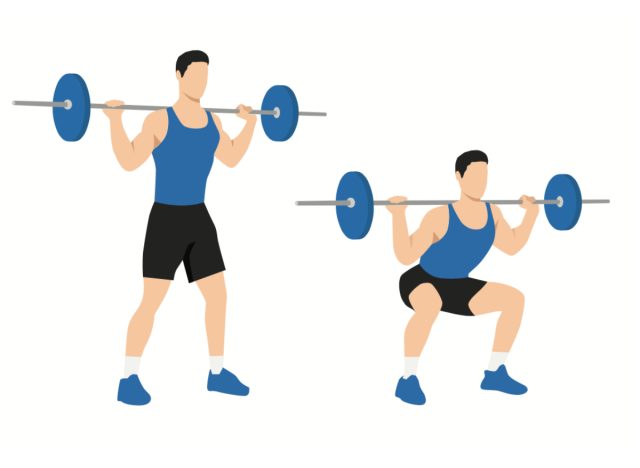
- Stand with feet shoulder-width apart, barbell resting on your upper back.
- Keep your chest up and core braced.
- Lower into a squat, making sure your knees track over your toes.
- Drive through your heels to return to standing.
2. Dumbbell Overhead Press
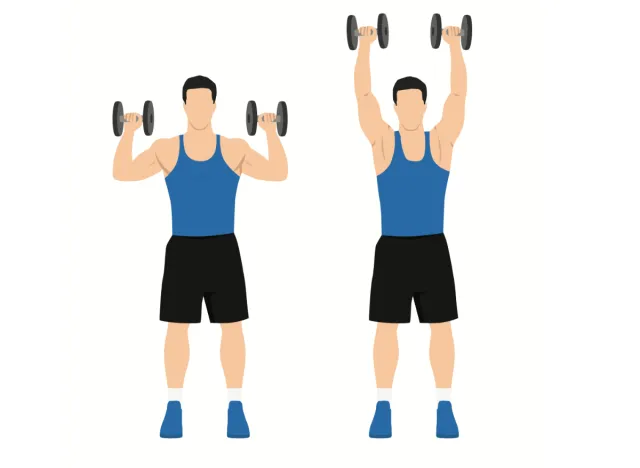
- Stand with feet hip-width apart, holding dumbbells at shoulder height.
- Press the dumbbells overhead until your arms straighten.
- Lower the dumbbells back to shoulder height.
3. Kettlebell Lunges
- Hold a kettlebell in each hand.
- Step forward with one leg, lowering your body until both knees are bent at 90 degrees.
- Push off your front foot to return to standing.
- Repeat on the other leg.
4. Barbell Bent-Over Rows
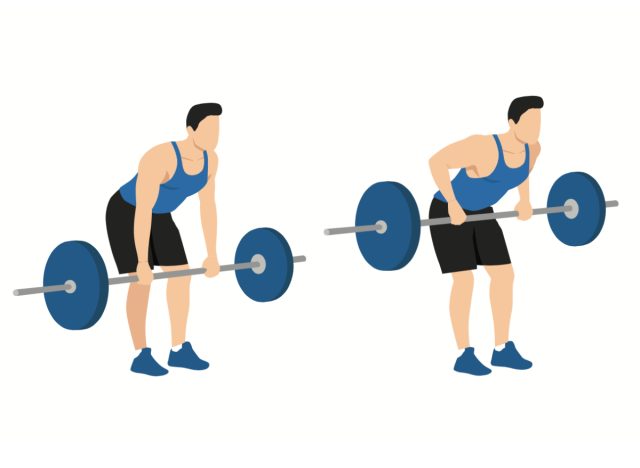
- Hold the barbell with an overhand grip, feet hip-width apart.
- Bend forward at the hips, keeping your back flat.
- Pull the barbell towards your torso, squeezing your shoulder blades together.
- Lower the barbell back down.
Day 4: Steady-State Intervals
What You Need: For this 40-minute cardio workout, you’ll need access to a cardio machine like a treadmill, rower, or assault bike. The workout combines steady-state and interval training, so be prepared to switch between moderate and high-intensity efforts throughout the session.
The Routine:
- 10 minutes steady-state at a moderate pace
- 1-minute moderate effort, 30-second sprint (intervals)
- Repeat for 20 minutes
- 10 minutes steady state at a moderate pace
Directions: Start the workout with 10 minutes of steady-state cardio at a moderate pace. After that, alternate between 1 minute of moderate effort and 30 seconds of a sprint or high-intensity burst for the next 20 minutes. Finish with another 10 minutes of steady-state cardio to cool down.
1. Steady-State Cardio (First 10 minutes)
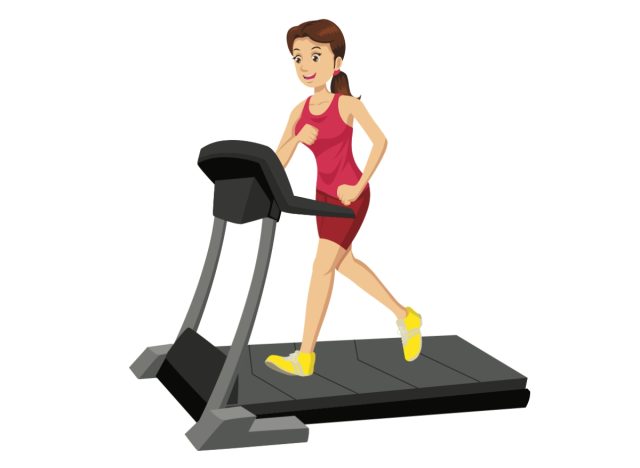
- Set your machine to a comfortable pace that you can maintain for 10 minutes.
- Keep your heart rate in a steady, moderate zone (about 60–70% of your maximum effort).
2. 1-Minute Moderate, 30-Second Sprint Intervals (20 minutes)

- After the first 10 minutes, switch to intervals.
- Push yourself hard for 30 seconds of sprinting or high-effort work.
- Recover at a moderate pace for 1 minute.
- Repeat this cycle for 20 minutes.
3. Steady-State Cardio (Last 10 minutes)
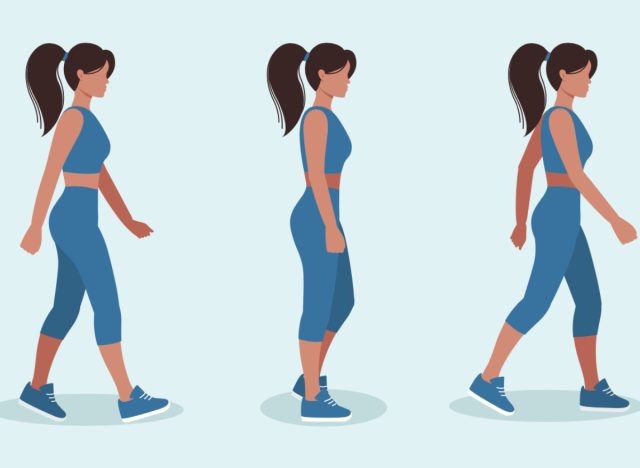
- After completing the intervals, lower the intensity to a moderate pace for 10 minutes to finish the workout.
Day 5: Full-Body Strength Circuit
What You Need: This circuit-based workout requires dumbbells, a barbell, and kettlebells and takes approximately 45 minutes to complete. You’ll move through different exercises targeting your legs, chest, and back while maintaining a quick pace to keep your heart rate elevated.
The Routine:
- Barbell Deadlifts – 4 sets of 8 reps
- Kettlebell Thrusters – 3 sets of 12 reps
- Dumbbell Lateral Lunges – 3 sets of 10 reps (each side)
- Dumbbell Pushups with Rows – 3 sets of 10 reps
Directions: Perform these exercises in a circuit, minimizing rest between exercises. After completing one full round, rest for 60–90 seconds—complete three rounds.
1. Barbell Deadlifts

- Stand with your feet hip-width apart, with a barbell on the ground in front of you.
- Grip the bar just outside your knees, keeping your back straight.
- Push through your heels and drive your hips forward to lift the bar.
- Lower it back down under control.
2. Kettlebell Thrusters
- Hold a kettlebell in each hand, resting them at shoulder height.
- Squat down, keeping your chest up.
- Explode up from the squat, pressing the kettlebells overhead.
- Lower the kettlebells back to shoulder height as you descend into the next squat.
3. Dumbbell Lateral Lunges
- Hold a dumbbell in each hand at your sides.
- Step to the side with one leg, bending that knee while keeping the other leg straight.
- Push through the bent leg to return to standing.
- Repeat on the opposite side.
4. Dumbbell Pushups with Rows
- Place two dumbbells on the floor, one under each hand.
- Perform a pushup, then row one dumbbell toward your ribs as you come back up.
- Alternate arms for the rows.
Day 6: Med Ball HIIT Workout
What You Need: For day six of your cutting routine, you’ll only need one piece of equipment—a medicine ball weighing between 10 and 20 pounds. This high-intensity workout takes about 30 minutes and focuses on explosive movements that engage your entire body, with plenty of core work included.
- Medicine Ball (10–20 lbs)
- 30 minutes
- Open space
The Routine:
- Med Ball Slams – 3 sets of 20 reps
- Med Ball Russian Twists – 3 sets of 15 reps (each side)
- Med Ball Squat to Press – 3 sets of 12 reps
- Med Ball Lunge with Twist – 3 sets of 10 reps (each side)
Directions: This is a high-intensity, full-body workout. Perform each exercise for the prescribed reps, with minimal rest between exercises. After completing the entire circuit, rest for 60–90 seconds and repeat for three rounds.
1. Med Ball Slams
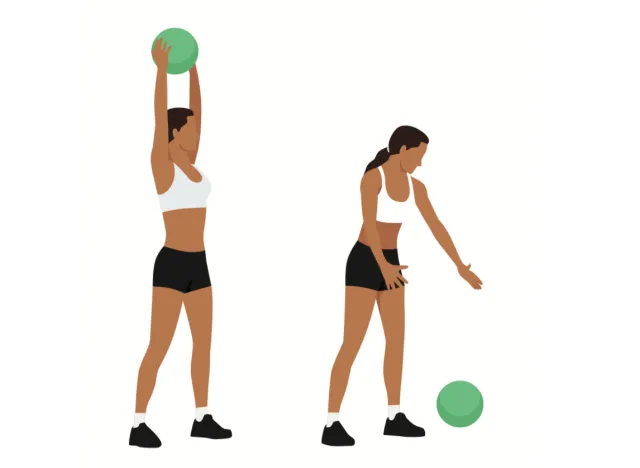
- Stand with feet shoulder-width apart, holding the med ball overhead.
- Slam the ball down to the ground as hard as possible, using your core and arms.
- Pick it up and repeat.
2. Med Ball Russian Twists
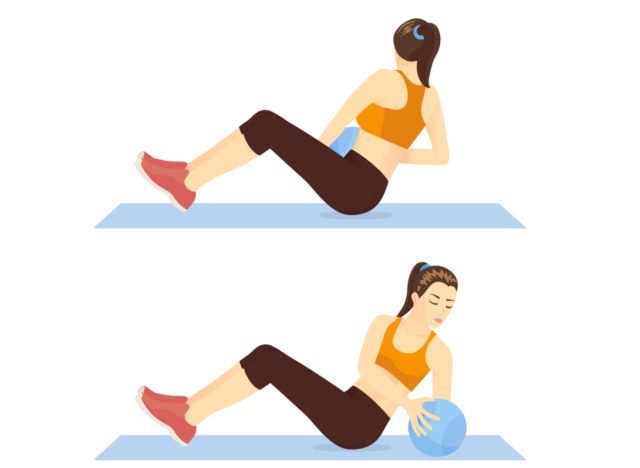
- Sit on the floor with your knees bent and feet lifted slightly off the ground.
- Hold the med ball close to your chest.
- Rotate your torso, touching the med ball to the ground on each side.
3. Med Ball Squat to Press
- Hold the med ball at chest height.
- Squat down, keeping your chest up and core tight.
- As you stand up, press the med ball overhead smoothly.
4. Med Ball Lunge with Twist
- Hold the med ball at chest height.
- Step forward into a lunge, twisting your torso towards the lead leg.
- Return to the starting position and repeat on the other side.
Day 7: Rest
To wrap up this cutting routine, take the final day to recover fully. You won’t need any equipment, but light movement, such as walking or stretching, can help with muscle recovery. Make sure to stay active, but prioritize rest to allow your muscles to repair and prepare for next week’s workouts.
Frequently Asked Questions About A Trainer’s 7-Day ‘Cutting’ Routine To Burn Fat & Get Ripped
What is a cutting routine?
A cutting routine is a workout and diet plan designed to help individuals lose body fat while maintaining muscle mass. It usually involves a calorie deficit and increased cardiovascular exercise to shed excess fat.
How long should I follow a cutting routine?
The duration of a cutting routine can vary depending on individual goals and starting points. Typically, a cutting phase can last anywhere from 4 to 12 weeks. It is essential to monitor progress and make adjustments as needed.
What should I eat during a cutting routine?
During a cutting routine, it’s crucial to focus on nutritious, whole foods that support fat loss and muscle retention. Include lean proteins, complex carbohydrates, healthy fats, and plenty of fruits and vegetables in your diet. It’s also essential to stay hydrated and avoid high-calorie, processed foods.
How often should I work out during a cutting routine?
Consistency is key during a cutting routine. Aim to work out at least 4-6 times per week, incorporating a mix of strength training and cardiovascular exercise. Rest and recovery are also crucial, so make sure to listen to your body and give it the rest it needs.
Can I modify the cutting routine to suit my fitness level?
Absolutely! It’s essential to tailor any workout routine to your fitness level and goals. If you’re new to exercise, consider starting with lighter weights and lower intensity cardio. As you progress, you can gradually increase the intensity and volume of your workouts to continue challenging your body.






